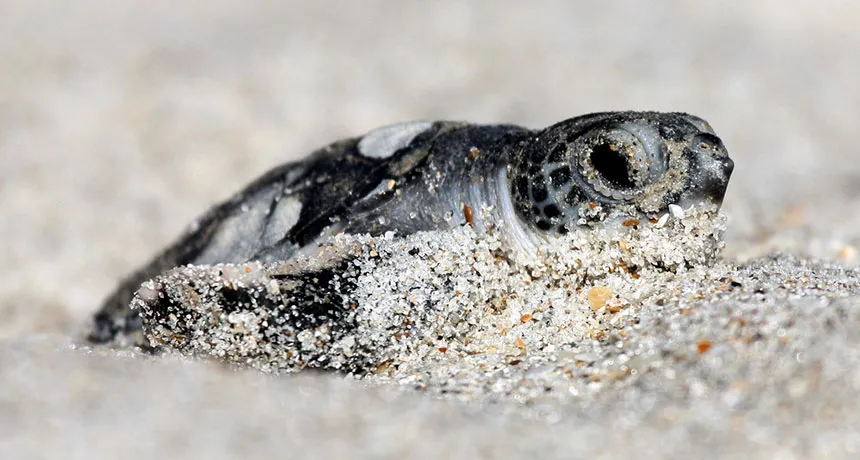For baby sea turtles, it helps to have a lot of siblings

New research shows that having lots of siblings in a nest could give a baby green turtle a better start in life.
U.S. Fish and Wildlife Service/Flickr (CC-BY 2.0)
- More than 2 years ago
Sea turtles do not have an easy start to life. After hatching, they have to break out of their shell, dig their way out from beneath the sand, then make a mad dash across the beach to the water where they may or may not find food and safety — hopefully without getting snapped up by a predator. All of this requires a bit of luck and a lot of energy. And the energy a hatchling expends on breaking out of the nest is energy that can’t be used on surviving the rest of the journey.
Now, a new study has quantified the amount of energy a baby sea turtle uses to dig itself to the surface. Having lots of siblings — and, thus, lots of help — can really be a time and energy saver, researchers report May 18 in the Journal of Experimental Biology. That also implies that the conservation technique of dividing clutches may instead make hatchlings worse off.
Figuring out the energy expenditure of baby sea turtles took some trial and error. Mohd Uzair Rusli of the University of Malaysia Terengganu and colleagues started by burying newly hatched green turtles beneath 40 centimeters of beach sand, but the hatchlings never started digging and the researchers abandoned the experiment after 48 hours. They suspected that the turtles might need a pocket of air, something that would naturally be found in between eggs.
The team then tried eggs that were just starting to hatch, orienting them so that the top of the egg — where a turtle had started to emerge — would be toward the sand surface. But instead of digging upwards, many of the turtles dug toward the side of the big sand-filled chamber. The researchers thought that the babies may have been drawn to light entering through the transparent chamber walls. “It appears that they can be attracted to light even when buried underground,” they note. This is perhaps not all that surprising given that researchers knew that baby turtles use cues from the sun to emerge most often at night or on cloudy days.
For the final experiment, the scientists buried clutches of eggs just about to hatch beneath 40 centimeters of beach sand in a chamber with opaque walls. Just above the eggs sat a strip of aluminum foil that, when broken, signaled the start of the digging-out process. A 24-hour webcam monitored the top of the sand so researchers could see when digging ended. The whole setup was then enclosed so that the scientists could measure oxygen consumption — a stand-in for energy expenditure. And the team was careful to stay quiet near the experiment, because they learned that talking near the buried turtles prompted the tiny hatchlings to dig.
Escaping from the sand took between 3.7 and 7.8 days, with larger clutches taking less time to emerge and also using less oxygen per hatchling. Digging behavior was not consistent during the whole time; the oxygen consumption rate rose and fell in peaks as the turtles dug and dug and dug together, rested and then started again. “In nature, it is likely that hatchlings receive a significant benefit by belonging to a large clutch,” the team concludes. They use less energy in their escape, leaving more for the mad dash to the sea and finding a first meal.
The researchers note that in some regions of the world, it is a common conservation strategy to split up clutches when relocating them into hatcheries. But this practice, they warn, could leave baby turtles with reduced energy reserves when they reach the ocean.






